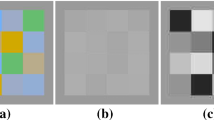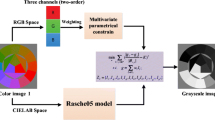Abstract
Image decolorization is to transform a color image into a grayscale image with the preserved contrast and consistent details. It is an important tool in image processing and realistic applications, such as monochrome printing and e-ink display. In this paper, we propose a novel contrast preserving method for image decolorization. Our main contribution is threefold: Firstly, we define a new contrast feature for a color image which combine the correlated information among R, G and B channels with the color contrast in each channel. Secondly, we propose to use the weighted normalized L1 norm to measure the distance between the grayscale image and the color image contrast features, and formulate an constrained optimization problem. Finally, we utilize a discrete searching solver to solve the optimization problem efficiently. The proposed decolorization method is good at preserving low contrast as well as high contrast structures in the color image. The objective and subjective evaluation on three benchmark datasets demonstrates that our decolorization method is effective and competitive with some state-of-the-art decolorization methods.




















Similar content being viewed by others
References
Ancuti C, Ancuti C (2016) Laplacian-guided image decolorization. In: 2016 IEEE international conference on image processing (ICIP). pp 4107–4111
Ancuti C, Ancuti C, Feixas M, Sbert M (2019) Image decolorization based on information theory. In: 2019 IEEE International conference on image processing (ICIP). pp 3242–3246
Ancuti C, Ancuti C, Bekaert P (2011) Enhancing by saliency-guided decolorization. In: Proc. IEEE Conf. Comput. Vis. Pattern Recognit.. pp 257–264
Ancuti C, Ancuti CHC, Bekaert P (2010) Image and video decolorization by fusion. In: Proc. Asian Conf. Comput. Vis. (ACCV). pp 79–92
Boyd S, Vandenberghe L (2006) Convex Optimization. New York: Cambridge Univ. Press.
Brunet D, Vrscay ER, Wang Z (2012) On the mathematical properties of the structural similarity index. IEEE Trans Image Process 21(4):1488–1499
Ĉadík M (2008) Perceptual evaluation of color-to-grayscale image conversions. In: Computer graphics forum, vol 27. Wiley Online Library, pp 1745–1754
Cai B, Xu X, Xing X (2018) Perception preserving decolorization. In: 2018 25th IEEE International conference on image processing (ICIP). pp 2810–2814
Chen H, Fang F (2019) Bregman-tanimoto based method for contrast preserving decolorization. In: 2019 IEEE International conference on multimedia and expo (ICME). pp 1240–1245
Du H, He S, Sheng B, Ma L, Lau RWH (2015) Saliency-guided color-to-gray conversion using region-based optimization. IEEE Trans Image Process 24 (1):434–443
Gonzalez RC, Woods RE (2007) Digital image processing, 3rd edn. Hoboken, Prentice-Hall Inc.
Gooch AA, Olsen SC, Tumblin J, Gooch B (2005) Color2gray: salience-preserving color removal. Acm Trans Graph 24(3):634–639
Grundland M, Dodgson NA (2007) Decolorize: Fast, contrast enhancing, color to grayscale conversion. Pattern Recogn 40(11):2891–2896
Hou X, Gong Y, Liu B, Sun K, Liu J, Xu B, Duan J, Qiu G (2018) Learning based image transformation using convolutional neural networks. IEEE Access 6:49779–49792
Liu DNJ, Fang F (2019) Color-to-gray conversion with perceptual preservation and dark channel prior. Int J Numer Anal Model 16(4):668–679
Jin Z, Li F, Ng MK (2014) A variational approach for image decolorization by variance maximization. SIAM J Imaging Sci 7(2):944–968
Kanan C, Cottrell GW (2012) Color-to-grayscale: does the method matter in image recognition? PloS one 7(1):e29740
Kim Y, Jang C, Demouth J, Lee S (2009) Robust color-to-gray via nonlinear global mapping. Acm Trans Graph 28(5):1–4
Liu C, Liu T (2013) A sparse linear model for saliency-guided decolorization. In: 2013 IEEE International conference on image processing. pp 1105–1109
Liu Q, Leung H (2019) Variable augmented neural network for decolorization and multi-exposure fusion. ELSEVIER Inf Fusion 46:114–127
Liu Q, Li S, Xiong J, Qin B (2019) Wpmdecolor: weighted projection maximum solver for contrast-preserving decolorization. Vis Comput 35 (2):205–221
Liu Q, Liu PX, Wang Y, Leung H (2017) Semiparametric decolorization with laplacian-based perceptual quality metric. IEEE Trans Circ Syst Vid Technol 27(9):1856–1868
Liu Q, Liu PX, Xie W, Wang Y, Liang D (2015) Gcsdecolor: Gradient correlation similarity for efficient contrast preserving decolorization. IEEE Trans Image Process 24(9):2889–904
Liu Q, Shao G, Wang Y, Gao J, Leung H (2017) Log-euclidean metrics for contrast preserving decolorization. IEEE Trans Image Process 26(12):5772–5783
Liu Q, Xiong J, Li Z, Zhang M, Wang Y (2017) Extended rgb2gray conversion model for efficient contrast preserving decolorization. Multimed Tools Appl 76(12):14055–14074
Liu S, Zhang X (2019) Image decolorization combining local features and exposure features. IEEE Trans Multimed 21(10):2461–2472
Lotto RB, Purves D (1999) The effects of color on brightness. Nat Neurosci 2(11):1010–1014
Lu C, Li X, Jia J (2014) Contrast preserving decolorization with perception-based quality metrics. Int J Comput Vis 110(2):222–239
Lu C, Xu L, Jia J (2012) Contrast preserving decolorization. In: Proc. IEEE int. conf. comput. photography (ICCP). pp 1–7
Lu C, Xu L, Jia J (2012) Real-time contrast preserving decolorization. In: Proc. SIGGRAPH Asia Tech. Briefs, pp 1–4
Ma K, Zhao T, Zeng Z, Wang K (2015) Objective quality assessment for color-to-gray image conversion. IEEE Trans Image Process 24(12):4673–4685
Martin D, Fowlkes C, Tal D, Malik J (2001) A database of human segmented natural images and its application to evaluating segmentation algorithms and measuring ecological statistics. In: Proc. 8th int’l conf. computer vision, vol 2. pp 416–423
Nafchi HZ, Shahkolaei A, Hedjam R, Cheriet M (2017) Corrc2g: color to gray conversion by correlation. IEEE Signal Process Lett 24(11):1651–1655
Shizume T, Ohashi G, Takamatsu H, Shimodaira Y (2015) Estimation of the helmholtz-kohlrausch effect for natural images. J Soc Inf Disp 22 (11):588–596
Smith K, Landes PE, Thollot J, Myszkowski K (2010) Apparent greyscale: A simple and fast conversion to perceptually accurate images and video. Comput Graph Forum 27(2):193–200
Wang W, Li Z, Wu S (2018) Color contrast-preserving decolorization. IEEE Trans Image Process 27(11):5464–5474
Wang W, Li Z, Wu S, Zeng L (2020) Hazy image decolorization with color contrast restoration. IEEE Trans Image Process 29:1776–1787
Wang Z, Bovik AC, Sheikh HR, Simoncelli EP (Apr. 2004) Image quality assessment: From error visibility to structural similarity. IEEE Trans Image Process 13(4):600–612
Zhang X, Liu S (2018) Contrast preserving image decolorization combining global features and local semantic features. Vis Comput 34(12):1099–1108
Acknowledgments
This work is supported in part by the National Natural Science Foundation of China (NSFC) (No. 61731009, No. 11671002), the Fundamental Research Funds for the Central Universities, Nature Science Foundation of Jiangsu Province (BK20181483), and Science and Technology Commission of Shanghai Municipality (No. 19JC1420102, No. 18dz2271000).
Author information
Authors and Affiliations
Corresponding author
Additional information
Publisher’s note
Springer Nature remains neutral with regard to jurisdictional claims in published maps and institutional affiliations.
Appendix
Appendix
1.1 A.1 Proof of Proposition 1
Proof
It is equivalent to prove: \(\forall x,y,z \in {\mathscr{A}}\),
-
(1) x ≤ y ≤ z or x ≥ y ≥ z, we need to proof
$$ |y-z|x^{2}-|y^{2}-z^{2}|x+yz|y-z|\geq 0. $$(32)As δ = (y − z)4 ≥ 0, (32) holds.
-
(2) x ≤ z ≤ y or x ≥ z ≥ y, we need to proof
$$ |y-z|x^{2}+3|y^{2}-z^{2}|x+yz|y-z|\geq 0. $$(33)As δ = (y − z)2(9z2 + 9y2 + 14yz) ≥ 0, (33) holds.
-
(3) y ≤ x ≤ z or y ≥ x ≥ z, we need to proof
$$ |y-x|z^{2}+3|y^{2}-x^{2}|x+xy|y-x|\geq 0. $$(34)As δ = (x − y)2(9x2 + 9y2 + 14xy) ≥ 0, (34) holds.
□
1.2 A.2 Proof of Proposition 2
Proof
For k ≠ 0,
□
1.3 A.3 Proof of Proposition 3
Proof
□
Proof
(of Proposition4) We set c ≥ 0 of the sublevel set Ac because q ≥ 0 on the domain.
∀x, z ∈ Ac, ∀t ∈ (0, 1),
□
Rights and permissions
About this article
Cite this article
Yu, J., Li, F. & Lv, X. Contrast preserving decolorization based on the weighted normalized L1 norm. Multimed Tools Appl 80, 31753–31782 (2021). https://doi.org/10.1007/s11042-021-11172-9
Received:
Revised:
Accepted:
Published:
Issue Date:
DOI: https://doi.org/10.1007/s11042-021-11172-9




